Thursday, January 26, 2006
Old tools
I have old planes (from France, the US and Japan), marking gages and saws (Japan).
It's a pleasure to give a new life to an old tool. I did it for a plow plane.
I took appart the plane and used steelwool to remove rust, and a small metal wheel on a mini-drill to clean other metalic parts. I sharpened the 2 knifes and the blade, and oiled them right after. As for the body, I used a scrapper to clean it.

The plow plane in pieces, before cleaning
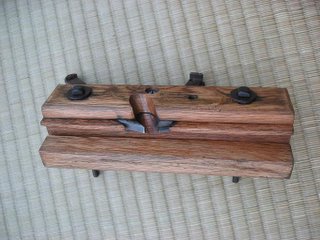
After cleaning and light oiling with camelia oil
Tuesday, January 24, 2006
Some of my work
Everything have been sawn by hand, choped by hand and 90% drilled with a brace. No nails.
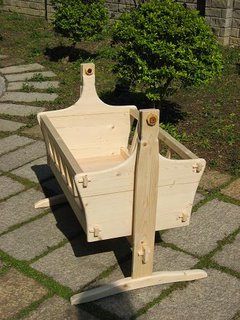
Cradle for my son

Bow saw.
Made from zitan, pterocarpus indicus (precious wood, intensivelly used in antique China for furniture) and stretcher is in guava (harvested in log form and resawn).
Rop in hemp.
Blade: turbo blade from Japan.

Camel, Lion and Bear.
Gifts for my son's first christmas.
Bear in camphor wood
Lion is made from a burl (but I don't know from which wood)
Camel is made from a hard exotic wood, with a very particular odor (I know the chinese name but not the common or scientific name)

Steam roller, gift for my son.
Wheels are in acacia (log formed with drawknife, rasp and spokeshave). Hole were made with the help of a drill press.

My son sitting on the small chair.
Chinese Juniper (very pleasant smell)
Top planed with a spoon bottom plane, finished with a scrapper
Monday, January 23, 2006
削ろう会 Kezurou-kai
 Kezurou-kai Gotemba, september 2005
Kezurou-kai Gotemba, september 2005
The gild of shaving gentlemen... Kezurou-kai is a group famous in Japan for its contests: the goal is to achieve the thinnest possible shaving. But it is much more than competition: it gathers two times a year woodworkers, craft -men and -women, blacksmith, temple builders and teachers.
My meeting with Kezurou-kai
Thanks to the web, I got in touch with the secretary of Kezurou-kai Japan, Sachiko. This was in october 2004. She wrote me I could go to their meeting that was happening just 3 days later. This was too short a notice for my first trip to Japan, but I had at least a contact from Japan.
Then at the end of february 2005, Sachiko let me know there is another meeting on the 5th of march in Miki city. I decide to go... though I didn't know where is Miki, didn't know any Japanese except few tools names, and new nothing about where to sleep and go to the meeting place. Well, that's fine, I was so happy I could go to Japan that I forgot about the unknowns.
Kezuroukai quaterly
Kezuroukai publishes a quaterly magazine. Sachiko and Mr Sugimura have been very kind to send it to me after my first meeting. It contains a lot of information on various subjects such as comparison test of planes, meeting minutes, interviews...
Miki-city (march 2005)
My first kezurou-kai meeting was to be the begining of my profound interest in Japanese tools and a deep sympathy with the Japanese people I have met. I hadn't heard about such kind people and hadn't met any.
I landed in Nagoya and was about to meet Sachiko for the first time. I had no idea how she looked, she only told me she was going to wear a red coat. I've found her no problem waiting for me. We drove to Mr Sugimura's workshop where I was going to spend the night. It was a bit cold in Japan in march. The next morning, Mr Sugimura and I drove to Miki. Sachiko couldn't join us.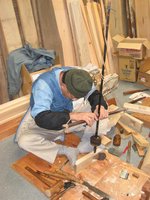
Mr Takashima (高島さん)using a pump drill on a dai during a dai maiking workshop. From left to right: Mr Ouchi, Mr Myiamoto, Mr Yamaguchi and Mr Sugimura.
From left to right: Mr Ouchi, Mr Myiamoto, Mr Yamaguchi and Mr Sugimura.
Highlights of my trip was actually after the meeting, when Mr Sugimura and I visited some blacksmiths.
宮本さん 高島さん 横山さん 仁村さん all gave me one hand plane while I and Mr Sugimura was visiting them to Miki-city.
Gotemba (september 2005)
My second trip to Japan and Kezuroukai meeting was also a great experience. This meeting was a "biiigg meeting" as Mr Sugimura said. It was indeed. It took place in Gotemba city, near the mount Fuji. Kezurou-kai America members were also present and it was nice to meet them.
There were a lot of activities: using an ax, forging a plane blade, workshops on how to use a saw, some metate (saw sharpeners), dai (plane body) makers, you could make your own marking knife... A lot of tools were also for sale.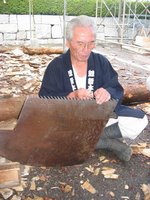
Mr Hayashi (林さん) sharpening his Maebiki.
Mr Hayashi wrote a book about sawing. A Taiwanese friend of mine helped to buy it. I can't read what's written, but can recognize few words and it is interesting anyway to look at the few pictures and drawings.
I was very surprised to see him at the meeting. One of the highlight of the meeting was to try one of his maebiki.
Mr Yamaguchi (sitting) giving direction to Mr Sugimura, Mr Kendo (saw maker) carefully observing.
Sunday, January 22, 2006
Kanna 鉋 かんな Planes
Right now I can't recall how I happen to be interested in Japanese tools, but the first one I got was given to me by a Taiwanese craftman (it happens that I will later have the chance to meet the maker of that plane, Mr Yamaguchi).
So... why Japanese versus others? It for sure has to do with my first visit to Japan. From Sachiko and Mr Sugimura to Mr Yamaguchi, the people I have met are sincerally good hearted. The tools I have been given have a soul for me. I have met there maker and talked to them. They symbolize the sympathy I've received from these Japanese woodworkers, craftmen, bladesmiths and students.
I was conforted in my orientation when a retired civil engineer asked me how I liked the Asuka (飛鳥) plane I had just ordered from an auction site. We have been regularly corresponding with each other since almost a year, sometimes on a daily basis. I wish I could meet him in person, either in Japan or anywhere else, because he appears to inspire the same Japanese sympathy as I've seen among Japanese woordworkers.
Here are pictures of some of my planes:
 This is the Magatama mokume (勾玉木目), made by Tesshinsai Houraku (鉄心斎芳楽)
This is the Magatama mokume (勾玉木目), made by Tesshinsai Houraku (鉄心斎芳楽)
常三郎の五壽年
Gojyunen, from Tsunesaburo
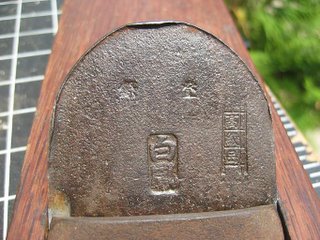
山口さんの白鳳
White Phoenix, from Yamaguchi-san
This is an old plane, given to me by a Taiwanese carpenter from Toufen, Miaoli. Red oak long dai.
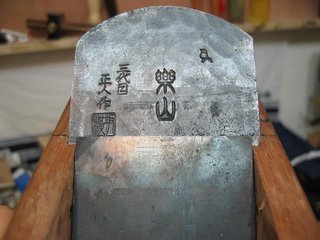
Rakusan
I won the blade and subblade (more exactly, Sachiko from Kezuroukai gave me a wining ticket. Thank you Sachiko! 幸子:ありがとうございます)
Hand work: Japanese tools and other interests!

こんにちは!大家好! Hello! Salut!
Welcome to my humble blog. I hope you'll find something interesting to read, learn or share!
The picture above is the one of my first Japanese tool. It's name is "White Phoenix", and was given to me by a Taiwanese craftman from Toufen city, Miaoli county, Taiwan. It is in red oak, and long body. The blacksmith is Yamaguchi (山口さん) from Miki city.
It was the spark that triggered my interests for handtools and Japanese tools in particular (note that the powder was ready to be ignited!).
As I have the opportunity, I will post about my other tools, my work, and why hand work matters.
I hope to write about how to use, set and care for hand tools, and Japanese tools in particular. I hope to tell about why I like Nikon Rangfinder cameras... and maybe a lot more!

